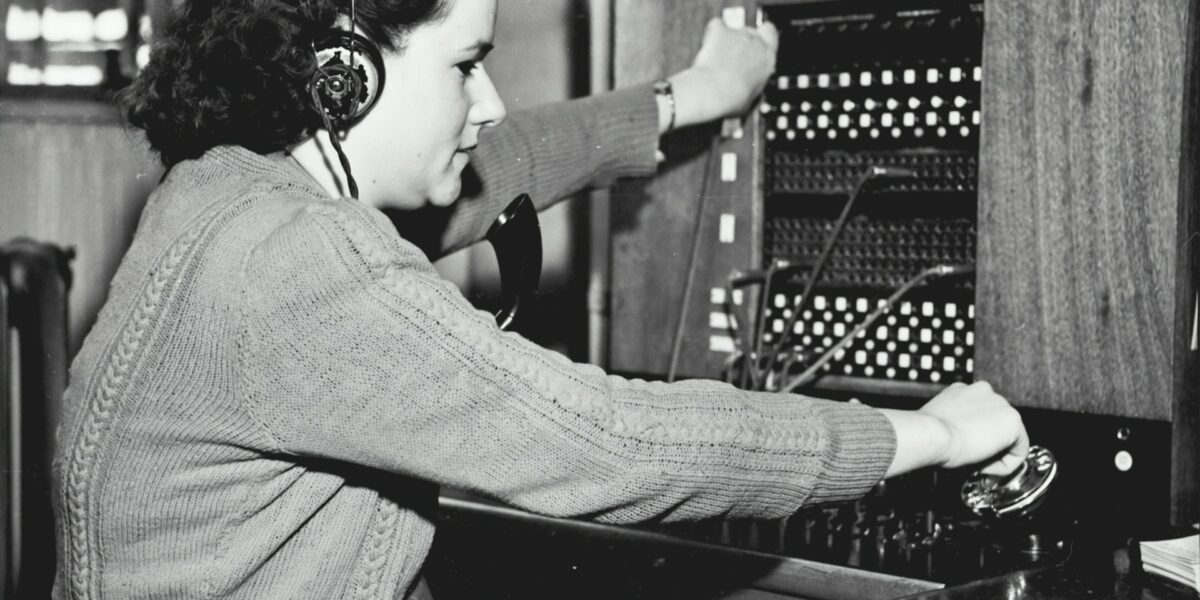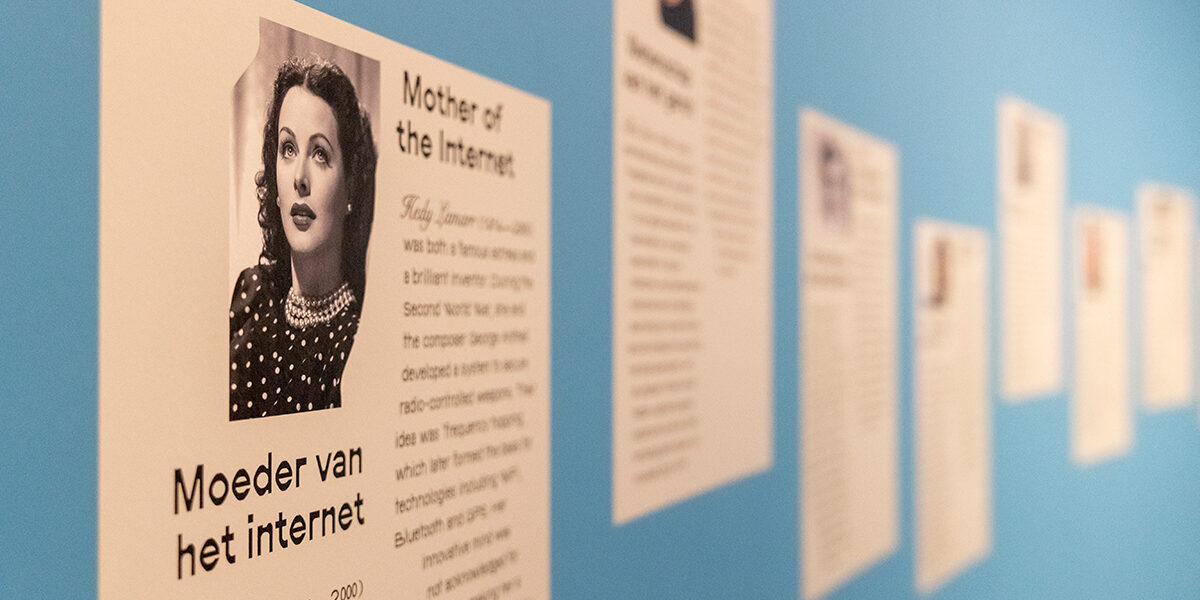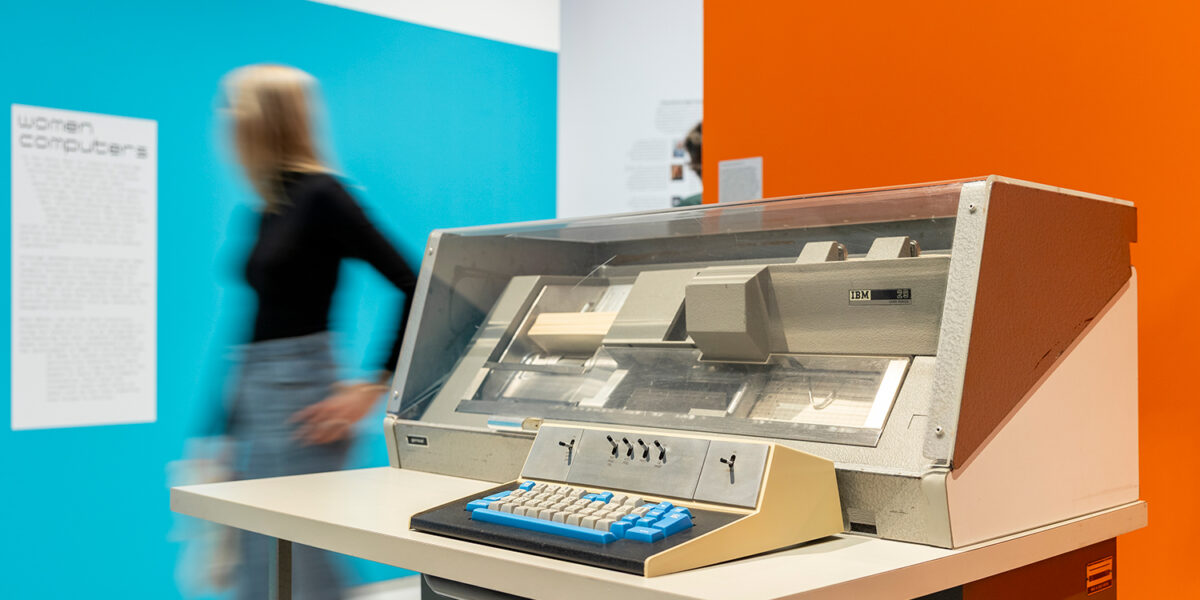Before ‘computers’ were machines, the word was used to describe women who performed complex calculations. Their work was indispensable, but was undervalued in terms of both status and pay. When machines took over these functions in Western Europe and North America, the balance of power shifted too: what had previously been a female domain was now redefined as male. Technology served here as an instrument that structurally excluded women from influence and recognition.
Text continues below the image.

Joan Howard operates a switchboard at Sunshine’s office, September 1949, Museum Victoria.
It was women who programmed the first digital computers, such as ENIAC in America and ARRA in the Netherlands, while men designed the hardware. The distinction was perpetuated in the associated terminology: ‘software’ suggested feminine qualities and ‘hardware’ masculine ones. A similar process occurred in the office: the first computer users were female secretaries, but as technology steadily gained socioeconomic kudos, male engineers and managers took control.
The pattern was repeated at home in the 1980s, with the computer whizz-kid as a new icon: brilliant, socially awkward and invariably male. Computers were marketed as something for the boys, while women were put off or downright excluded from working in programming, a field they had once led.
What had been seen as trivial, women’s work, now formed the backbone of the digital world. Control of data and technology became a decisive factor in global politics. Meanwhile, women might have ceased to press the buttons, but their supposed qualities are nevertheless emulated by technology: AI and robots are praised for their conscientious accuracy, care robots mimic empathy and virtual assistants have a female voice. Tech companies run predominantly by men are using these things to shape the future. What would it take to ensure that history does not repeat itself?
The paradox of the data revolution
The loom invented by Joseph Marie Jacquard (1752–1834) revolutionized the manufacture of textiles using perforated cards to weave intricate patterns. This had traditionally been female work, with women spinning and weaving textiles at home and in small workshops. Skills were passed down from mother to daughter and played a crucial role in the economy and social structures.
Industrialization brought dramatic change, mechanizing handicrafts and relocating them to factories. Technology was increasingly seen as a male preserve in which engineering was linked to positions of power and masculine professional identities. Machines and technical systems were viewed as rational, powerful and objective, while women were associated with nurturing, emotion and domesticity, placing them outside the domain of technology.
The binary system that underpinned the jacquard loom also formed the basis for modern computer technology. The British inventors Charles Babbage (1791–1871) and Ada Lovelace (1815–1852) adopted the same perforated cards for their respective mechanical computers. The principle was developed further by the American Herman Hollerith (1860–1929), whose punched-card technology laid the foundations for the immense success enjoyed by IBM. The machines that created the cards were mostly operated by women, who were valued for their precision and patience. Yet their crucial contribution was barely recognized as technological expertise.
Women computers
In the early days of computer technology, it was women who performed the complex calculations. The projects they worked on – often using pencil and paper – paved the way toward modern information technology. Their calculations grew more urgent during the Second World War: military technology required a speed and precision that surpassed human capabilities. While both male and female mathematicians were called on to develop devices that could perform such calculations, their roles and the recognition they received differed significantly.
Although mathematically trained women made an indispensable contribution, they were largely excluded from engineering roles. Scientific institutions viewed women as temporary staff and leadership roles for them were at odds with prevailing social norms. As a result, they were mostly employed to perform calculations, with men securing the managerial positions.
When ENIAC, one of the first electronic computers, was built, it took six women to bring the machine to life by designing and implementing the first computer programs. Women also played an indispensable part in the development of ARRA in the Netherlands. At NASA too women performed the calculations essential to space missions, yet long remained in the shadow of their male colleagues. Ironically, their work and ultimately their jobs would be taken over by the very computers they helped to develop.
Gender and status
Automation drastically changed the business working environment in the 1960s and 70s. As the importance of computers grew within companies, operating them increasingly became a male domain. It was not just the technology itself that triggered this shift, but above all the way companies introduced it. The deployment of new technologies was often met with uncertainty and even fear on the part of employees. Businesses were aware of this and developed strategies to manage such unease, an important part of which was to raise the status associated with operating and managing the new devices.
Control of computer systems was framed as complex and high-quality work, for which special courses and training were organized. This led in turn to the creation of new roles such as programmer and operator, which were filled almost exclusively by men. Women, who had previously been responsible for calculation and programming work, were relegated to routine, auxiliary tasks such as typing and data entry.
Advertisements reinforced this image by showing men as the operators of powerful machines, with women in supporting roles. In this way, technology became an instrument of progress, but also a means of legitimizing social exclusion. The more prominently computers featured in the conduct of business, the more women faded into the background.
The whizz-kid takes over
Information technology in the 1980s was very much a boys’ affair. A culture grew up around computers in which technology, autonomy and competition were at the heart. Movies like Weird Science portrayed them as an extension of boys’ fantasies, while women were rarely depicted as creators, designers or users of any significance. If they featured at all, it was as a helper, consumer or the person who ‘doesn’t get it’.
The design and marketing of computers played a key part in this too, with home computers presented as technical toys for boys. Interfaces were abstract and manuals complex, if not to exclude then certainly to suggest who belonged. One exception was the ‘Matra Alice’ – a playful and friendly design aimed at girls too. For that very reason, the computer did not match the norm and so proved a commercial flop.
There was a reaction at the same time among women campaigners. Feminist groups and women’s vocational schools tried to reclaim technology as a field for everyone. Courses, textbooks and campaigns stressed that exclusion was a matter of culture rather than nature. All the same, the image persisted of technology as rational and autonomous and hence as implicitly male, something that continues to this day. Not so much in the shape of explicit exclusion, but of who identifies with technology and who still has to ask to be allowed in.
Women’s work
A National Exhibition of Women’s Work was staged in The Hague in 1898 to highlight something that was otherwise frequently ignored. It included an illustration titled ‘Some professions in which women are not employed’, including those of lawyer and wallpaperer. Stylized women are shown wielding supposedly male tools and other attributes. Work is allocated, according to the print, based not on what a person is capable of, but on their gender. It is in this respect that the absurdity of such exclusion is felt most acutely. The absence of women highlights the kind of work that they did perform: care, education and services.
Women’s work is defined by what a society recognizes as such: not by the work itself, but by the body we imagine performing it. As far back as 1206, for instance, the Book of Knowledge of Ingenious Mechanical Devices by the Muslim scholar Al-Jazari describes several mechanical servants, of which only the one designed to pour tea is female: not for any technical reason, merely to make her task socially recognizable.
Nowadays, robots are increasingly performing tasks in the care, hospitality and education sectors that have historically been viewed as ‘female’. It is striking how they are given female voices or body shapes, even though – once again – there is no technical requirement to do so. Given technology’s propensity to reinforce inequality, would it not be better to use it in a way that breaks with outdated role patterns?









